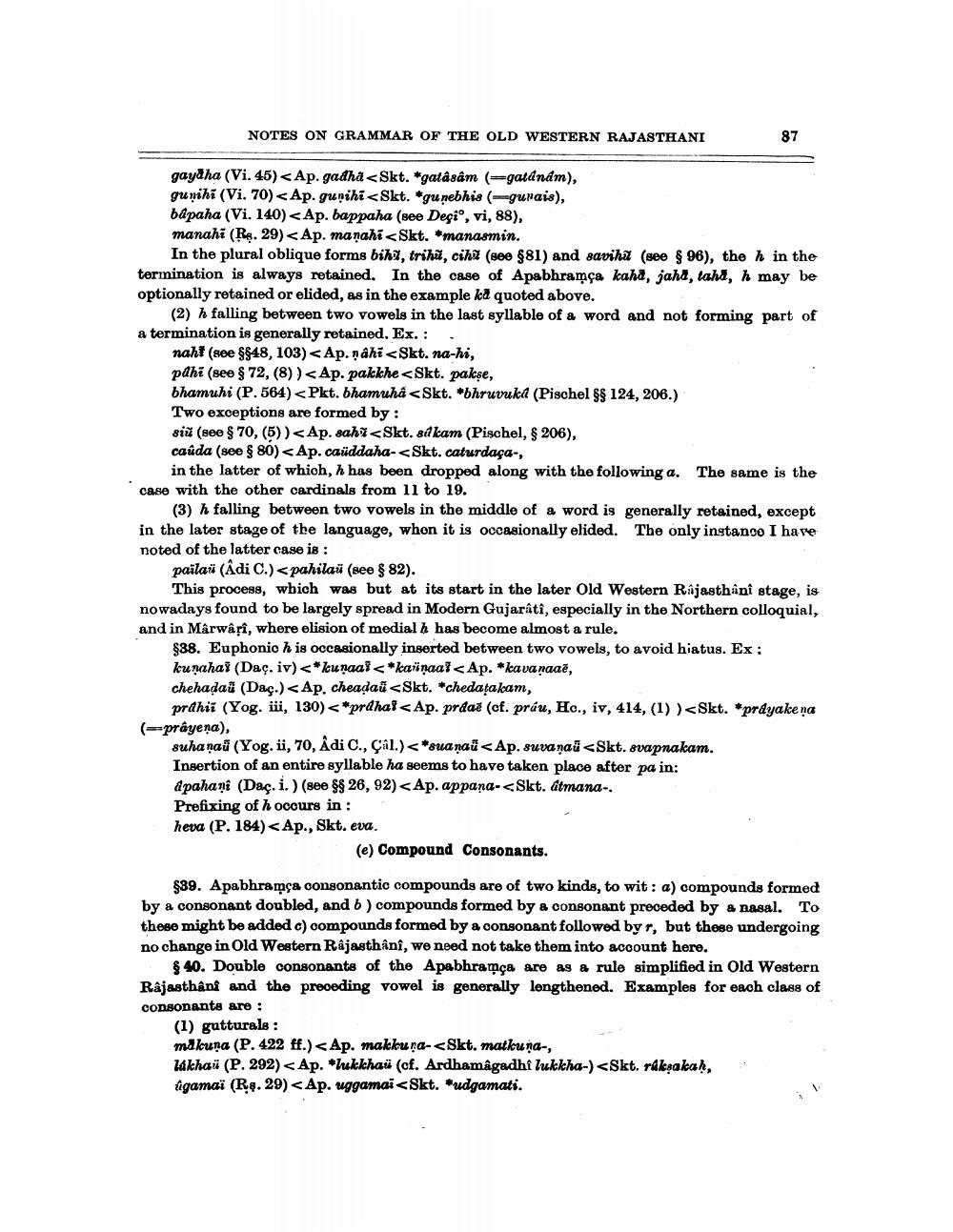________________
NOTES ON GRAMMAR OF THE OLD WESTERN RAJASTHANI
87
gaydha (Vi. 45) <Ap.gadha<Skt. *gatásâm (-gardndm), gunihi (Vi. 70) <Ap. gunihi <Skt. *gunebhis (gurais), bápaha (Vi. 140) < Ap. bappaha (see Degio, vi, 88), manahi (Ra. 29) < Ap. manahi <Skt. *manasmin.
In the plural oblique forms bih2, trihu, cih (see $81) and saviha (see $ 96), the h in the termination is always retained. In the case of Apabhramça kaha, jaha, laha, h may be optionally retained or elided, as in the example ked quoted above.
(2) h falling between two vowels in the last syllable of a word and not forming part of a termination is generally retained. Ex.:
naht (see 8848, 103) <Ap.nahi <Skt. na-hi, pdhi (see & 72, (8)) <Ap. pakkhe <Skt. pakse, bhamuhi (P. 564) <Pkt. bhamuhâ <Skt. *bhruvuka (Pischel &$ 124, 206.) Two exceptions are formed by : siū (see $ 70, (5)) <Ap.sahi Skt. sd kam (Pigchel, $ 206), caúda (800 & 80) <Ap. caüddaha- <Skt. caturdaça-,
in the latter of which, h has been dropped along with the following a. The same is the case with the other cardinals from 11 to 19.
(3) h falling between two vowels in the middle of a word is generally retained, except in the later stage of the language, whon it is occasionally elided. The only instanco I have noted of the latter case is :
pailaü (Adi C.) <pahilaü (see $ 82).
This process, which was but at its start in the later Old Western Rajasthani stage, is nowadays found to be largely spread in Modern Gujarati, especially in the Northern colloquial, and in Marwârî, where elision of medial h has become almost a rule.
$88. Euphonic h is occasionally inserted between two vowels, to avoid hiatus. Ex : kunahai (Dac. iv) <*ku naai < *kainaal <Ap. *kava naaē, chehadai (Dac.) <Ap. cheadaü <Skt. *chedatakam,
prahii (Yog. iii, 130) < *prdhai < Ap. prdač (cf. práu, Ho., iv, 414, (1) ) <Skt. *prdyake na (-prayena),
suhanau (Yog.ii, 70, Adi C., Çal.) < *suanaữ < Ap. suva nau <Skt. avapnakam. Insertion of an entire syllable ha seems to have taken place after pa in: dpahani (Dac. i.) (see $S 26, 92) < Ap.appana.<Skt. Atmana-. Prefixing of h occurs in: heva (P. 184) Ap., Skt. eva.
(e) Compound Consonants.
$89. Apabhramça consonantic compounds are of two kinds, to wit: a) compounds formed by a consonant doubled, and 6 ) compounds formed by a consonant preceded by a nasal. To these might be added c) compounds formed by a consonant followed by r, but these undergoing no change in Old Western Rajasthani, we need not take them into account here.
$40. Double consonants of the Apabhramça are as a rule simplified in Old Western Rajasthani and the preceding vowel is generally lengthened. Examples for each class of consonants are :
(1) gutturals : maluna (P. 422 ff.) < Ap. malekura- <Skt. matkuna-, lákhaü (P. 292) < Ap. *lukkhaü (cf. Ardhamâgadhi lukkha-) <Skt. ráksakaḥ, ügamaï (Rp. 29) <Ap.uggamai<Skt. *udgamati.




